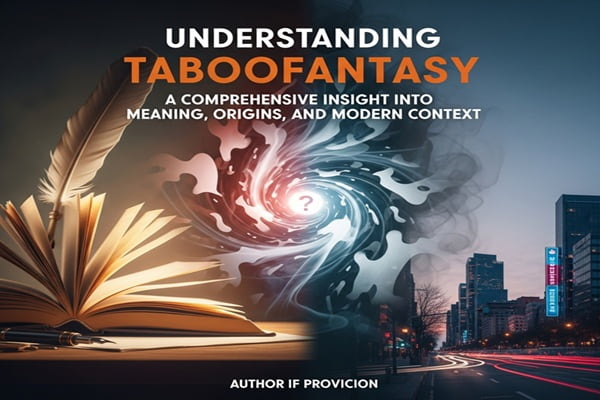
What Exactly Is “Taboofantazy”?
Let’s be honest—people have always been drawn to what’s considered off-limits. That’s exactly where the concept of Taboofantazy comes in. The term blends two powerful ideas: “taboo”—something that society labels as forbidden or inappropriate—and “fantasy”—the limitless space of imagination where anything can happen.
Together, taboofantazy describes a creative and psychological space where curiosity meets the forbidden. It’s where people explore thoughts, stories, and emotions that might be too unconventional—or even controversial—for mainstream conversation.
Some see it as a bold artistic expression that pushes cultural boundaries. Others are more cautious, viewing it as something that should be handled delicately. Either way, taboofantazy sits at the crossroads of art, psychology, and social exploration—making it one of the most thought-provoking ideas of our time.
Why Taboofantazy Captivates the Human Mind
Human imagination rarely stays confined within rules or expectations. Our minds often wander into unspoken territories—sometimes to question them, sometimes just to understand them. That’s what makes taboofantazy so intriguing: it reflects the natural human urge to explore the unknown.
You can find traces of it everywhere—from ancient myths and classic literature to modern films and online communities. While its expression changes with culture and time, the essence remains the same: exploring what lies beyond the accepted norm.
The Origins and Meaning Behind Taboofantazy
The word itself is a modern creation born out of digital culture—a place where niche ideas and bold artistic experiments thrive.
-
“Taboo” comes from the Polynesian term tapu, meaning something sacred or restricted.
-
“Fantasy” comes from the Greek phantasia, referring to imagination or mental imagery.
When you combine the two, you get the idea of imagining what’s forbidden—a concept that’s both thrilling and introspective. Every society throughout history has had its own taboos—subjects considered too delicate or controversial for open discussion. And yet, fantasy has always offered a safe space to explore them.
That’s the magic of taboofantazy—it lets creators push boundaries while inviting audiences to think deeply about what those boundaries really mean.
The Psychology Behind the Forbidden
So why are people drawn to things that are off-limits? Psychologists believe it’s tied to curiosity and the allure of restriction. When something is labeled “forbidden,” our brains naturally want to explore it.
Here’s how experts break it down:
-
A Safe Outlet: Exploring taboo themes in art or fiction can help people process emotions, confront fears, or simply understand themselves better.
-
Mental Exercise: It challenges moral reasoning and empathy—by imagining complex situations, we think more critically about human behavior.
-
Potential Risk: The key is balance. When fantasy gets confused with reality, it can lead to unhealthy perceptions. That’s why awareness and context are vital.
Essentially, taboofantazy is neither “good” nor “bad.” It’s a tool—a mirror that reflects how individuals and societies handle the things they fear or repress.
How Culture Shapes the Meaning of Taboofantazy
What’s taboo in one country may be perfectly normal in another. Culture defines boundaries—and taboofantazy challenges them.
Take a look at how different regions interpret it:
| Region | Common Themes | Cultural Attitude | Example Mediums |
|---|---|---|---|
| Western Europe | Moral ambiguity, historical transgressions | Generally open and artistic | Literature, indie films |
| East Asia | Supernatural themes, ancestral tension | Respectful and cautious | Folklore, anime |
| Middle East | Religious or moral restrictions | Highly regulated | Poetry, allegory |
| North America | Social taboos, counterculture movements | Mixed acceptance | Digital art, satire |
| Africa | Mythological and moral themes | Context-specific | Oral storytelling, theatre |
This diversity shows how taboofantazy serves as a cultural thermometer. It reveals what societies value, what they fear, and what they’re willing to question.
Taboofantazy in Literature, Art, and Media
From ancient myths to modern streaming platforms, artists have long used taboofantazy to provoke thought and spark emotion. It’s often a way to discuss difficult subjects indirectly—through symbols, metaphors, or allegory.
Here’s how it appears across creative forms:
| Medium | Example Use | Effect | Audience Reaction |
|---|---|---|---|
| Literature | Symbolic novels or poetry | Encourages reflection and debate | Admired for depth |
| Film & Theatre | Suggestive or abstract storytelling | Stirs empathy and controversy | Mixed but passionate |
| Digital Art | Surreal or immersive visuals | Expands creative boundaries | Divided reactions |
| Gaming | Ethical decision-making plots | Promotes moral reflection | Highly engaged niche |
| Music & Poetry | Hidden or coded metaphors | Preserves artistic freedom | Often praised |
The digital age has only expanded this space. Online platforms, fan fiction sites, and interactive storytelling tools have made it easier for creators to explore taboo themes responsibly—and for audiences to engage with them thoughtfully.
The Ethical Tightrope
Here’s where taboofantazy gets tricky. While it’s a legitimate creative outlet, it can also raise ethical questions. How do we balance freedom of expression with responsibility?
Critics worry about:
-
Desensitization to sensitive subjects
-
Blurring the line between fiction and harmful reality
-
The risk of misinterpretation, especially by younger audiences
Supporters argue that:
-
Exploring taboo ideas through fiction helps society talk about them safely
-
Art can question moral norms without endorsing them
-
Censorship often prevents meaningful dialogue
The truth likely lies somewhere in the middle. Context, intent, and audience awareness make all the difference. When handled thoughtfully, taboofantazy can open conversations that society often avoids.
Also Read : Zaxby’s menu with prices 2024
The Future of Taboofantazy
As technology evolves, the concept of taboofantazy is set to evolve with it. With tools like virtual reality, AI-driven storytelling, and immersive experiences, creators can now explore human imagination in ways that feel real—but remain safe.
Future possibilities include:
-
VR Worlds: Immersive environments where users can safely explore complex emotions.
-
AI Storytelling: Algorithms that adapt stories to reflect the user’s comfort level.
-
Collaborative Spaces: Online communities that create together while respecting ethical guidelines.
Of course, these advancements will also bring new debates about privacy, consent, and the influence of digital fantasy on real behavior. The goal will always be the same—balance creativity with responsibility.
Key Takeaways
-
Taboofantazy is the meeting point of imagination and restriction—a space where the forbidden becomes art.
-
It has deep cultural, psychological, and ethical roots, shaping how people express and explore ideas.
-
When used responsibly, it can challenge social norms and spark meaningful conversations.
-
With modern technology, it’s entering a new era of immersive storytelling that demands careful thought and empathy.
Frequently Asked Questions
1. What does taboofantazy mean?
It refers to imaginative or creative expressions that explore themes considered socially or culturally forbidden.
2. Is taboofantazy harmful?
Not necessarily. Its impact depends on intent, context, and how well audiences understand it as fiction or art.
3. Does it differ across cultures?
Yes. Cultural values shape what is considered taboo, so interpretations vary widely around the world.
4. Can it inspire positive change?
Absolutely. Many artists use taboo themes to challenge stereotypes, question injustices, and encourage dialogue.
5. What’s next for taboofantazy?
With advances in VR and AI, expect more interactive and personalized forms of storytelling—along with deeper ethical discussions.
Final Thoughts
Taboofantazy isn’t just a creative niche—it’s a reflection of human nature. It invites people to think beyond comfort zones, question social rules, and explore how imagination can both reveal and reshape who we are.
Handled wisely, it’s not about crossing moral lines—it’s about understanding why those lines exist in the first place.
As technology blurs the boundary between imagination and experience, taboofantazy will continue to remind us of something timeless: curiosity, creativity, and conscience will always go hand in hand.


